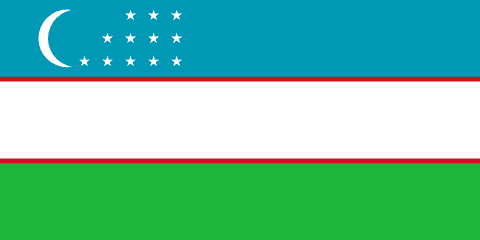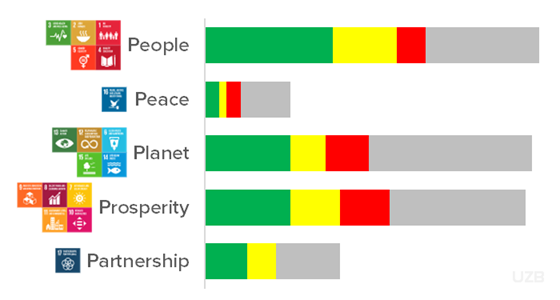Central Asia - Uzbekistan

Uzbekistan, has made significant progress in achieving the United Nations’ Sustainable Development Goals (SDGs) since adopting the agenda in 2015. Uzbekistan has undertaken a range of measures to promote sustainable development across its economy, society, and environment. Some notable achievements include reducing poverty and inequality, improving access to healthcare and education, and promoting gender equality. In 2023, Uzbekistan presented its second Voluntary National Review (VNR) at the United Nations High-Level Political Forum on Sustainable Development, which highlighted the country’s progress and identified priorities for future action. The VNR also showcased Uzbekistan’s commitment to sustainable development and its efforts to align its policies with the SDGs.
Progress in SDGs

Based on Global SDG Indicators and Diagnostics 🟩 On Track 🟨 Mixed / For Review 🟥 Off Track ⬛ Trends NA
SDG Accelerators
🔷 4.3. Quality education for everyone. Investments in human capital is a crucial accelerator for the whole SDG agenda for Uzbekistan. Ensuring equal access for all to quality education produces relevant skills (Target 4.4) for youth, which is key in the age of rapid economic and social change, as well as being a driver of sustainable industrialization and digitalization. Investments in secondary education (Target 4.1) and competitive skills (Target 4.3) could help young people to set out on a future-proof path, ensuring employment (Target 8.6), and contribute to accelerated economic growth (Target 8.1).
Addressing evident differences (Target 10.1) in education by expanding options for boys and girls will contribute to women’s empowerment (Target 5.5). Investment in women and girls across all levels of decision-making in political and economic life (Target 5.5) and enhancement in the use of technology to empower women (Target 5.b) contribute to achieving this target. Sustainable urbanization, including transportation services (Targets 11.1, 11.2) and targeted inclusion policies for disadvantaged group (Targets 1.3, 10.3) will contribute to improving equality of opportunities.
🔷 8.3. Policies for economic development. The policies for accelerated, inclusive and sustainable growth of Uzbekistan’s economy (Target 8.3) aim at improving the well-being of the population. These policies seek to achieve faster economic growth (Target 8.1) through sustainable industrialization (Target 9.1), digitalization (Target 9.c) and trade facilitation (Targets 8.a, 17.10, 17.11).
The growth has the potential to increase agricultural productivity (Target 2.3) and industrial productivity (Targets 9.2, 9.3) – both development priorities for Uzbekistan. Digitalization, which lies at the heart of these policies, requires developing quality, reliable, sustainable and resilient infrastructure, including ICT (Targets 9.1, 9.c)
Economic growth policies should resolve trade-offs with the quality of economic growth, namely achieve the sustainable management and efficient use of natural resources (Target 12.2) and of resource efficiency (Target 8.4), increasing energy efficiency (Targets 7.2, 7.3) and, ultimately, decoupling economic growth from environmental degradation while ensuring climate resilience (Targets 13, 14, 15).
🔷 11.1. Safe and affordable housing and basic services. In Uzbekistan the quality of life – in terms of affordable housing and basic services – varies significantly by regions. On average only 59% of the population is using safely managed drinking water services, while in urban areas this rate is much higher at 86%, compared to only 31% in rural areas.
Non-sustainable urbanization and lack of affordable fuels result in high air pollution in urban areas, affecting the health of the population (Target 3.9). Providing universal access for all to adequate, safe and affordable housing and basic services requires investments in resilient infrastructure (Targets 9.1, 9.4) to make them climate change and disaster ready (Targets 1.5, 13.2). Investment in women and girls across all levels of decision-making in political and economic life (Target 5.5) and guarantee of their rights to access and control resources (Targets 1.4, 5.a) will also contribute to improving the well-being and resilience of livelihoods.
It will contribute to reducing inequalities (Goal 10) and also to reducing conflicts (Goal 16). Measures to decrease multidimensional poverty (Target 1.2) and to tackle inequalities (Goals 10) are deeply rooted in improving well-being and in building the resilience of livelihoods. It also could have a positive impact on the sustainability of ecosystems (Goals 6, 14, 15)
🔷 12.2. The sustainable management and efficient use of natural resources (Green Economy). The policies for accelerated growth would not be relevant, if they were not delivering inclusive and sustainable growth. Target 12.2, focusing on sustainable use of natural resources, lies at the heart of the Green Economy. It is closely linked with sustainable and inclusive agricultural practices (Targets 2.3, 2.4, 2.5), energy transition (Targets 7.2, 7.3), sustainable infrastructure (Targets 9.1, 9.4) and an inclusive economy (Targets 1.4, 2.3, 4.4, 5.5, 10.3).
Building a just and inclusive economy requires investment in women and girls across all levels of decision-making in political and economic life (Target 5.5) and guarantee of their rights to access and control of resources (Targets 1.4, 5.a). The goal of the green economy is decoupling economic growth from environmental degradation while ensuring climate resilience (Targets 13, 14, 15).
Building the green economy – one of the strategic goals of Uzbekistan – requires resolving short-term trade-offs with the pressing needs of accelerated growth. It requires providing transitory social protection measures to those affected by the transition (Target 1.3), building skills for the future (Target 4.4) and investments in sustainable infrastructure (Targets 9.1, 9.4) using innovative finances (Target 17.3).
The dynamic map shows SDG Accelerators for Uzbekistan.
Use buttons to highlight certain paths and Focus to explore certain targets
See 📊 SDG Push Diagnostic for Uzbekistan
Read the 📑 Integrated SDG Insights Report for Uzbekistan
Voluntary National Reviews
🌐 Voluntary National Review 2023
🌐 Voluntary National Review 2020
